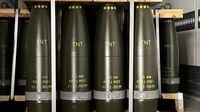In the quiet town of Unterlüß, nestled in the rolling heathlands of Lower Saxony, Germany, a transformation is underway that could reshape the landscape of European security. On April 22, 2025, the open-source intelligence account OSINTtechnical reported that German defense giant Rheinmetall’s new artillery plant in this small community will produce up to 350,000 artillery shells annually, nearly doubling its initial target of 200,000. This development, centered in a town of fewer than 4,000 residents, signals more than just an industrial expansion; it reflects a broader shift in Europe’s defense priorities amid ongoing conflicts and rising global tensions.
The Unterlüß facility, officially named Werk Niedersachsen, broke ground in February 2024 with a ceremony attended by German Chancellor Olaf Scholz, Danish Prime Minister Mette Frederiksen, and German Defense Minister Boris Pistorius. Rheinmetall, one of the world’s leading producers of artillery and tank ammunition, is investing approximately $341 million in the project, which is expected to create 500 new jobs and begin production in 2026.
The plant will focus primarily on 155mm artillery shells, a NATO-standard munition critical to modern warfare, as well as 1,900 tons of RDX explosives and components for rocket artillery. This ambitious undertaking is part of Rheinmetall’s broader goal to scale its global production to 1.1 million artillery shells by 2027, a significant leap from the 70,000 rounds it manufactured annually before Russia’s invasion of Ukraine in 2022.
The 155mm artillery shell, the centerpiece of Werk Niedersachsen’s output, is a versatile and powerful munition used in howitzers like the American M777, the German PzH 2000, and the French CAESAR. Measuring about 23 inches in length and weighing roughly 100 pounds, these shells can deliver high-explosive, smoke, or precision-guided payloads over distances exceeding 18 miles, depending on the gun system and charge. Rheinmetall’s portfolio includes advanced variants like the Vulcano, which can strike targets up to 43.5 miles away with laser-guided precision, and prototype shells with ranges reaching 62 miles.
These capabilities make the 155mm shell indispensable in high-intensity conflicts, where artillery barrages often dictate battlefield outcomes. By comparison, Russia’s 152mm shells, used in systems like the 2S19 Msta-S howitzer, offer similar destructive power but lack the precision and interoperability of NATO’s 155mm standard. China’s PLZ-05 howitzer also employs 155mm shells, reflecting the global convergence on this caliber, though Western designs emphasize modularity and advanced fuzing.
Rheinmetall’s decision to nearly double Unterlüß’s production capacity stems from urgent geopolitical realities. The war in Ukraine has exposed critical shortages in NATO’s ammunition stockpiles, with Ukraine firing up to 2,000 shells daily against Russia’s 10,000, according to a March 2024 report by Euromaidan Press. European and American production, estimated at 1.2 million shells annually, lags behind Russia’s 3 million, bolstered by imports from North Korea. Rheinmetall has emerged as a key player in addressing this gap, supplying Ukraine with hundreds of thousands of shells since 2022, often through contracts funded by Germany and other NATO partners.
A June 2024 framework agreement worth $9.1 billion will see Rheinmetall deliver 155mm shells to replenish German and allied stocks while supporting Ukraine’s defense efforts, with deliveries starting in 2025. Beyond Ukraine, the Unterlüß plant underscores Europe’s push for strategic autonomy in defense. Historically reliant on American military support, European nations are now grappling with the prospect of reduced U.S. commitments, particularly following shifts in American policy under the Trump administration.
Rheinmetall’s CEO, Armin Papperger, has emphasized the need for Germany to achieve “strategic sovereignty” in large-caliber ammunition, a sentiment echoed in the company’s February 2024 press release: “Previous dependency on export permits issued by other countries will thus be eliminated.” Werk Niedersachsen will create a complete value-added chain in Unterlüß, producing shells, fuzes, explosive charges, and propellants on-site. This self-sufficiency reduces vulnerabilities in global supply chains, a critical consideration given Europe’s reliance on countries like China for nitrocellulose, a key component in smokeless powder.
The technological challenges of scaling up production are formidable. Nitrocellulose shortages have plagued the defense industry, with global demand outstripping supply as manufacturers compete for limited stocks. Rheinmetall has invested in automation and modular production systems to boost efficiency, aiming to set new standards for ammunition manufacturing. The Unterlüß plant’s scalable design allows for potential expansion beyond 350,000 shells, a flexibility that could prove vital if conflicts escalate.
However, this rapid buildup raises questions about long-term sustainability. If the war in Ukraine ends, will Europe face an oversupply of munitions, or will these investments position it for future threats, such as tensions in the Indo-Pacific over Taiwan? Rheinmetall’s global footprint, with plants in Spain, Lithuania, and Ukraine, suggests a strategic bet on sustained demand.
Unterlüß itself is no stranger to the defense industry. For 125 years, Rheinmetall’s operations in the town have shaped its economy and identity, employing about 2,500 people in the development and production of tracked vehicles, lasers, and ammunition. The new plant will reinforce this legacy, but it also brings challenges. The influx of 500 jobs is a boon for a community with an aging population, yet it has sparked debate among residents. Some welcome the economic opportunities, seeing the factory as a lifeline for local businesses. Others, including environmental and peace activists, question the moral implications of producing weapons in a town surrounded by nature reserves.
Protests have been small but vocal, with local groups arguing that the plant’s expansion could strain infrastructure and exacerbate Germany’s role in global conflicts. The human dimension of Unterlüß’s transformation mirrors broader tensions across Europe. As defense budgets swell—Germany alone plans to spend $40 billion replenishing its ammunition stocks—public opinion is divided. A 2024 report by the European Council on Foreign Relations noted growing skepticism among Europeans about the prioritization of military spending over social programs and green initiatives.
In Germany, the push for rearmament under incoming Chancellor Friedrich Merz, who has vowed to make Germany “Ukraine’s arsenal,” has intensified these debates. Merz’s rhetoric, reported by Kyiv Post in April 2025, provoked a sharp response from the Kremlin, highlighting the geopolitical stakes of Europe’s military buildup.
Rheinmetall’s ambitions extend beyond Unterlüß. The company is building plants in Ukraine, Lithuania, and Hungary, and negotiating expansions in Poland and Romania. Its Ukrainian facility, expected to exceed its initial target of 150,000 shells annually by 2026, represents a bold move to integrate production into a warzone. This global strategy positions Rheinmetall as a linchpin in NATO’s efforts to counter Russian aggression and prepare for emerging threats.
Yet it also underscores the disparity between Western and adversary capabilities. Russia’s reliance on North Korean shells and Iran’s drone technology has allowed it to sustain its war effort, while China’s expanding defense industry looms as a long-term challenge. The People’s Liberation Army’s artillery systems, while less battle-tested than NATO’s, benefit from China’s vast industrial base, raising questions about the West’s ability to compete in a prolonged conflict.
Historically, artillery has been a decisive factor in warfare, from the massed barrages of World War I to the precision strikes of modern conflicts. The war in Ukraine has reaffirmed its centrality, with both sides expending shells at rates unseen since the 20th century. NATO’s pre-2022 complacency, marked by depleted stockpiles and underfunded production, left it ill-prepared for this reality. Rheinmetall’s pre-war output of 70,000 shells annually was a fraction of current needs, a gap that competitors like South Korea’s Hanwha Defense have also sought to fill.
The Unterlüß plant’s role in this race cannot be overstated. By 2026, it will be Europe’s second-largest artillery production site, trailing only Rheinmetall’s Spanish facility, which produces 450,000 shells annually. This output will not only bolster NATO’s immediate needs but also signal to adversaries that Europe is serious about its defense.
For American audiences, the implications are twofold. First, Europe’s push for autonomy could ease the burden on U.S. military resources, allowing Washington to focus on the Indo-Pacific. Second, it raises questions about coordination within NATO, as differing priorities and production capacities could strain alliance cohesion.
As Unterlüß prepares to take center stage, the town’s transformation reflects a paradox. A community rooted in pastoral tranquility is now at the heart of Europe’s rearmament, a microcosm of the continent’s struggle to balance security, morality, and economic priorities. Rheinmetall’s bold investment in Werk Niedersachsen is a testament to its vision of a stronger, self-reliant Europe, but it also serves as a reminder of the costs of global instability.
The plant’s 350,000 shells will soon ripple across battlefields and balance sheets, shaping conflicts and alliances in ways that are only beginning to emerge. In the end, Unterlüß is more than a footnote in the defense industry’s resurgence; it is a symbol of Europe’s awakening to a new era of uncertainty. Rheinmetall’s gamble on mass production could secure the continent’s defenses or fuel a cycle of escalation, depending on how the world evolves. For now, the quiet heathlands of Lower Saxony hum with the promise of power—and the weight of responsibility. Will Unterlüß become a beacon of European resolve or a cautionary tale of a world racing toward conflict? Only time will tell.






